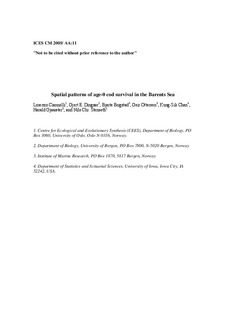| dc.description.abstract | Apart from human harvest, recruitment dynamics is conceivably recognized as the main source of population variability of marine fish stocks. Factors affecting recruitment dynamics can change over both temporal and spatial scales. It follows that at the same time, over the entire range of distribution of a single population, different individuals may experience different level of environmental forcing and survival, which may not be well represented by average conditions throughout the entire distribution range. In this study we focus on the spatial pattern and its relative sources of variability in the survival of the Arcto-Norwegian cod (Gadus morhua L.) from the age-0 to the age-1 stage. This is a delicate phase of the cod pre-recruitment dynamics, as individuals are confronted with a suite of survival challenges, such as settlement, pre-winter body condition, growth, and predation avoidance. During the over 20 years analyzed (1980-2004), we found that on average age-0 cod experience lower survival in the areas north of the Norwegian
coastline, from about 71 to 75 degree of latitude north and about 20 to 35 degree of
longitude east. However, in coastal areas, immediately north of the Norwegian coastline,
age-0 cod experience greater survival. Within the studied area, the average survival of
age-0 cod is significantly greater during years with low adult cod and high capelin
abundance, and high Arctic Oscillation. In addition, when capelin abundance is high, age-0 cod experience better survival particularly near the Norwegian coastline. Based on these results it appears that within the sampled grid the observed geographic patterns of age-0 cod survival is affected by the predation from adult cod in relation to the availability and distribution of capelin (Mallotus villosus), the alternative and preferred prey of adult cod. Climate can affect the spatial survival of age-0 cod by both affecting the distribution of their predators (e.g., adult cod) and the distribution and availability of
zooplankton prey. | en |
